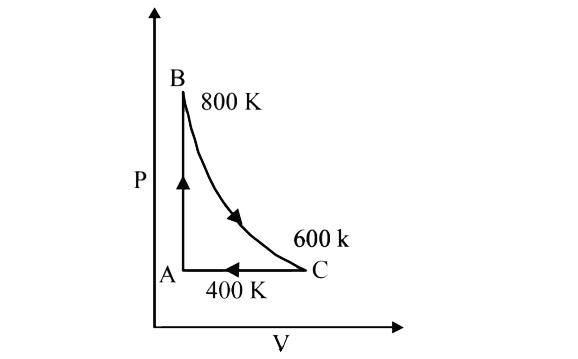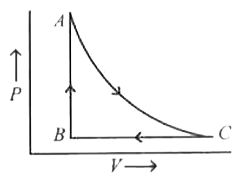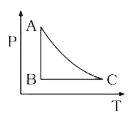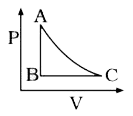One mole of diatomic ideal gas undergoes a cyclic process ABC as shown in fig. The process BC is adiabatic. The temperature at A, B and C are 400 K, 800 K and 600 K, respectively. Choose the correct statement.

The change in internal energy in whole cyclic process is 250 R
The change in internal energy in the process CA is 700 R
The change in internal energy in the process AB is -350 R
The change in internal energy in the process BC is -500 R
The correct Answer is:D
Change in internal energy,
(i) process CA is
UA−UC=Cv(400−600)=−200Cv
=−200×52R
=−500R
(ii) Process AB is
UB−UA=Cv(600−400)=400×52R
=1000R
(iii) Process BC is
UC−UB=Cv(600−800)=−200×52R
=−500R
(iv) the cycle ABCA is UA−UA=0
We used the property of an ideal gas that U is a function of temperature only.
Then from the 1st law of the Remo dynamics,
Q=(U2−U1)+W
We get for a process at constant volume,
Cv(T2−T1)=(U2−U1)+0
i.e, U2−U1=Cv(T2−T1)
For a diatomic ideal gas, Cv=52R.
Topper's Solved these Questions
- FIRST AND SECOND LAW OF THERMODYNAMICSBOOK - CHHAYA PUBLICATIONCHAPTER - FIRST AND SECOND LAW OF THERMODYNAMICSEXERCISE - Examination Archive with solution (AIPMT)
6 Videos
- FIRST AND SECOND LAW OF THERMODYNAMICSBOOK - CHHAYA PUBLICATIONCHAPTER - FIRST AND SECOND LAW OF THERMODYNAMICSEXERCISE - Examination Archive with solution (NEET)
7 Videos
- FIRST AND SECOND LAW OF THERMODYNAMICSBOOK - CHHAYA PUBLICATIONCHAPTER - FIRST AND SECOND LAW OF THERMODYNAMICSEXERCISE - Examination Archive with solution (WBJEE)
8 Videos
- EXPANSION OF SOLIDS AND LIQUIDSBOOK - CHHAYA PUBLICATIONCHAPTER - EXPANSION OF SOLIDS AND LIQUIDSEXERCISE - CBSE SCANNER
2 Videos
- FRICTION BOOK - CHHAYA PUBLICATIONCHAPTER - FRICTION EXERCISE - CBSE SCANNER
7 Videos
Similar Questions
One mole of a diatomic ideal gas undergoes a cyclic process ABC as shown in figure. The process BC is adiabatic. The temperature at A,B and C are 400K, 800K and 600K respectively. Choose the correct statement:

View SolutionOne mole of a diatomic ideal gas undergoes a cyclic process ABC as shown in figure. The process BC is adiabatic. The temperature at A,B and C are 400K, 800K and 600K respectively. Choose the correct statement:

View Solution
Knowledge Check
One mole of a diatomic ideal gas undergoes a cyclic process ABC as shown in figure. The process BC is adiabatic. The temperature at A,B and C are 400K, 800K and 600K respectively. Choose the correct statement:
 AThe change in internal energy in whole cyclic process is 250R.BThe change in internal process CA is 700R.CThe change in internal energy in the process AB is -350R.DThe chang in internal energy in the process BC is -500R.
AThe change in internal energy in whole cyclic process is 250R.BThe change in internal process CA is 700R.CThe change in internal energy in the process AB is -350R.DThe chang in internal energy in the process BC is -500R.One mole of ideal gas undergoes a cyclic process ACBA as shown in figure. Process AC is adiabatic. The temperatures at 1, B and C are 300 K,600 K and 450 K respectively. Choose the correct statement.
 AIn process CA, change in internal energy is 225 R.BIn process AB, change in internal energy is -150 RCIn process BC, change in intenal energy is -225 R.DChange in internal energy during the whole cyclic process is +150 R.
AIn process CA, change in internal energy is 225 R.BIn process AB, change in internal energy is -150 RCIn process BC, change in intenal energy is -225 R.DChange in internal energy during the whole cyclic process is +150 R.An ideal gas undergoes a cyclic process as shown in the given P-T diagram, where AC is adiabatic. The process is also represented by:
 A
A B
B C
C D
D
n moles of a diatomic gas has undergone a cyclic process ABC as shown in figure. Temperature at A is T0. Find

Volume at C ?
View Solutionn moles of a diatomic gas has undergone a cyclic process ABC as shown in figure. Temperature at a is T0. Find volume at C

View Solutionn moles of a diatomic gas has undergone a cyclic process ABC as shown in figure. Temperature at A is T0. Find
 Total heat given to gas ?
Total heat given to gas ?
View SolutionAn ideal gas undergoes a cyclic process as shown in the given P-T diagram, where AC is adiabatic. The process is also represented by:

View SolutionThe internal energy (U) of an ideal gas is plotted against volume for a cyclic process ABCDA, as shown in the figure.

The temperature of the gas at B and C are 500 K and 300 K, respectively. The heat absorbed by the gas (in cal/mol) in this cyclic process, is :
View Solution
